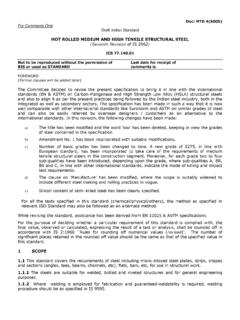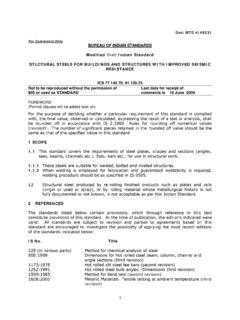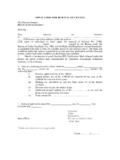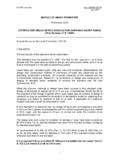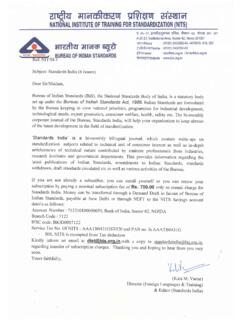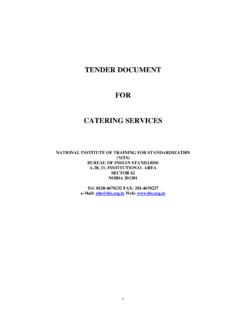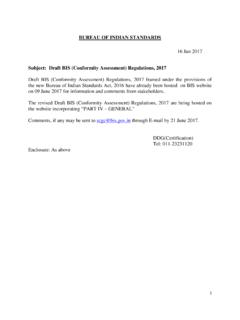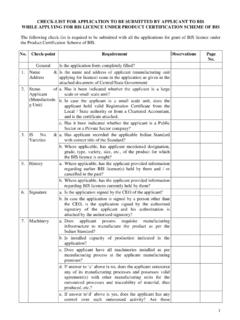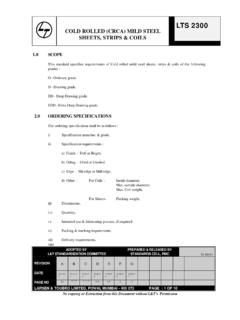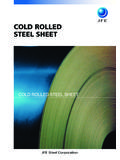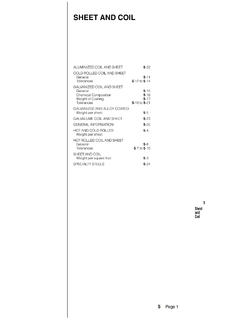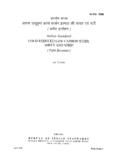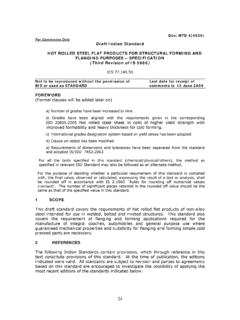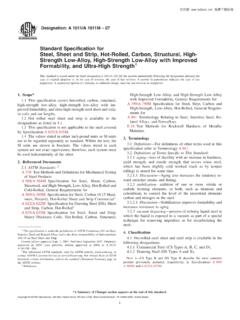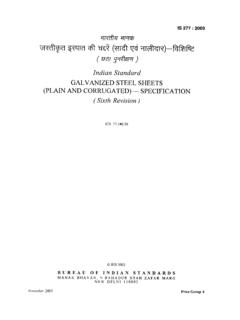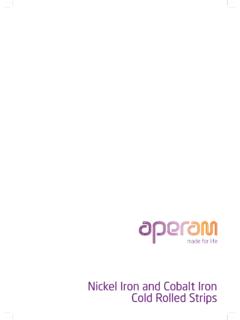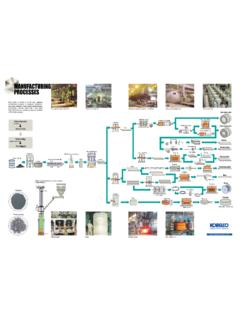Transcription of COLD REDUCED LOW CARBON STEEL SHEET AND …
1 Doc: MTD 4(4670) 1 For comments only Draft Indian Standard cold REDUCED LOW CARBON STEEL SHEET AND STRIP (Fifth Revision of IS 513) ICS Not to be reproduced without permission Last date for receipt of Of BIS or used as STANDARD comments is 31 May 2006 FOREWORD (Formal clause will be added later on). In the preparation of this draft standard, consideration has been given to the manufacturing and trade practices followed in the country in this field. In the present revision, the following modifications have been made: a) ISO designations have been adopted; b) New grade CR5 Extra Deep Drawing (stabilized interstitial free)has been added; c) Co-relation of old designations with new designations has been given for information (Annex A); d) A new clause on references has been incorporated e) Amendment No. 1 and 2 have been incorporated; f) Values for plastic anisotropy (r) and strain hardening exponent (n) have been incorporated; g) Applicable period for mechanical and physical properties has been included; h) Requirements of dimensions and tolerances have been separated from the standard and adopted ISO 16162:2005 i) A clause for alternate test method specified in relevant ISO/IEC standard has been added.
2 Assistance has been derived from the following: ISO 3574:1999 cold - REDUCED CARBON STEEL SHEET of commercial and drawing qualities BS EN 10130: 1991 cold rolled low CARBON STEEL flat products for cold forming: technical delivery conditions For the purpose of deciding whether a particular requirement of this standard is complied with, the final value, observed or calculated, expressing the result of a test or analysis, shall be rounded off in accordance with IS 2:1960. The number of significant placed retained in the rounded off value should be the same as that of the specified value in this standard. 1 SCOPE This draft standard covers the requirements of cold REDUCED low CARBON STEEL sheets and strips for bending and drawing purpose and where the surface is of prime importance. It covers sheets and strips up to mm thick both in coil form and cut lengths.
3 2 REFERENCES The following standards contain provisions which through reference in this text, constitute provision of this standard. At the time of publication, the editions indicated were valid. All standards are subject to revision and parties to agreements based on this standard are encouraged to investigate the possibility of applying the most recent editions of the standards indicated below: IS No. Title 228 (Relevant Parts) Method for chemical analysis of STEEL 1501:2000 Method for vickers hardness test for metallic material (third revision) 1586:2000 Method for Rockwell hardness test for metallic material (Scales A-B-C-D-E-F-G-H-K) (third revision) 1599:1985 Method for bend test (second revision) Doc: MTD 4(4670) 21608:2005 Metallic materials Tensile testing at ambient temperature (third revision) 1387:1993 General requirements for the supply of metallurgical materials (second revision) 10175:1993 Mechanical testing of metals-Modified erichson cupping test SHEET and strip Pt 1 Thickness up to 2 mm (first revision) 11999:1983 Method for determination of plastic strain ratio `r for STEEL sheets Doc.
4 MTD 3(4659) Metallic Materials SHEET and Strip Determination of `Tensile Strain Hardening Exponent Doc:MTD 3(4694)/ Continuously cold -rolled STEEL SHEET products Dimensional and ISO 16162:2005 shape tolerances 3 CLASSIFICATION OF GRADES Sheets and strips shall be classified in the CR1, CR2, CR3, CR4 and CR5 grades/designations. 4 SUPPLY OF MATERIAL General requirements relating to the supply of cold rolled low CARBON STEEL sheets and strips shall conform to IS 1387. Sheets and strips may be supplied either with mill or trimmed edges. Sheets and strips of CR1 grade may be supplied in any of following tempers. Sheets and strips of CR2, CR3, CR4 and CR5 grade shall be supplied in annealed and skin passed condition. Temper Temper Processing Designation H Hard Produced by heavy cold rolling 1/2H Half hard Produced by cold rolling followed by annealing and further cold rolling to give strip of intermediate hardness 1/4H Quarter --do - Hard SP Skin Passed Produced by light cold rolling after annealing A Annealed Produced by a final annealing process For specific applications, sheets and strips may also be supplied in any other temper subject to agreement between the supplier and the purchaser.
5 Non-ageing Characteristics The manufacturer shall guarantee the absence of stretcher strains on being cold worked in the case of non-ageing quality with a non-ageing guarantee for 6 months from the date of dispatch. CR4 and CR5 grade sheets and strips shall be supplied only in non-ageing quality with a non-ageing guarantee for 6 months from the date of dispatch. A stability test as per Annex B may be carried out to assess the non-ageing characteristics of skin passed stabilized steels with mutual agreement between the manufacturer and the purchaser. The STEEL shall be considered stabilized if the percentage increase in load does not exceed 6 when tested as per Annex B. 5 MANUFACTURE The method of manufacture of the STEEL for sheets and strips shall be left at the discretion of the manufacturer. Doc: MTD 4(4670) 3 Sheets and strips shall be supplied rimmed, semi-killed or killed as agreed between the purchaser and the manufacturer.
6 However, CR4 and CR5 grade shall be supplied only in fully aluminium killed or in a fully stabilized condition. 6 CHEMICAL COMPOSITION Ladle Analysis The ladle analysis of STEEL , when carried out either by the methods specified in relevant part of IS 228 or any other established instrumental/chemical method, shall be as given in Table 1. In case of any dispute, the procedure given in relevant parts of IS 228 shall be the referee method. Alternatively the method specified in relevant ISO/IEC standard may be used. Product Analysis Permissible variation in the case of product analysis from the limits specified in Table 1 shall be as given in Table 2. Table 1 Chemical Composition Quality Constituent, Percent, Max Designation Name CARBON Manganese Sulphur Phosphorus Titanium CR1 Commercial - CR2 Drawing - CR3 Deep Drawing - CR4 Deep Drawing Aluminium Killed (non-aging) - CR5 Extra Deep Drawing (stabilized interstitial free)
7 NOTES 1 Restricted chemistry for CR4 and CR5 grade may be mutually agreed between the purchaser and the supplier. 2 When the STEEL is killed by aluminium alone the total aluminium content should be percent. When steels is silicon killed, the silicon content shall not be less than percent. When the STEEL is aluminium-silicon killed, the silicon content shall not be less than percent and total aluminium content shall not be less than percent. 3 The nitrogen content of the STEEL shall not be more than percent. However for CR1, the nitrogen content shall not exceed percent. This shall be ensured by the manufacturer by occasional check analysis. 4 The material may be supplied in the copper bearing quality in which case the copper shall be between and percent on ladle analysis. In case of product analysis, the copper content shall be permissible in between and percent.
8 5 The STEEL can be made with micro-alloying elements like niobium, cadmium, titanium and boron either individually or in combination, on mutual agreement in which case the total micro-alloying elements should not exceed percent in ladle analysis. However, in case of boron, the limit shall be percent. Table 2 Permissible Variation for Product Analysis (Clause ) Constituent Variation Over Specified Limit, Percent, Max CARBON Manganese Sulphur Phosphorus NOTE Product analysis shall not be applicable to rimming STEEL Doc: MTD 4(4670) 4 7 MECHANICAL AND PHYSCIAL PROPERTIES Tensile Test Tensile test shall be carried out only if specified by the purchaser.
9 When specified, the tensile test shall be carried out in accordance with IS 1608 as applicable, and the values of tensile strength, yield stress and percentage elongation shall conform to the requirements specified in Table 3. Tensile test values apply to transverse specimen in case of SHEET /strips. Strips having a width of 250 mm and below shall be tested longitudinally. The yield strength values apply to the percent of proof stress if the yield strength is not clearly distinctive, otherwise the values apply to lower yield strength. Table 3 Mechanical Properties at Room Temperature in as Delivered Condition for Annealed/Skin Passed Sheets and Strips (Cut Lengths and Coils) (Clauses and ) Quality Elongation Percent A Min Hardness Max Designation Name Yield Stress Re MPa Max Tensile Strength Rm MPa Max Lo= 80mm Lo= 50mm HRB HR (30T) r-bar Min n-bar Min (1) (2) (3) (4) (5) (6) (7) (8) (9) (10)
10 CR1 Commercial 280 410 27 28 See Table 4 - - CR2 Drawing 240 370 30 31 65 60 - - CR3 Deep Drawing 220 350 34 35 57 55 - - CR4 Deep Drawing Aluminium Killed (non-aging) 210 350 36 37 50 50 - - CR5 Extra Deep Drawing (stabilized interstitial free) 190 350 38 38 - - NOTES 1 1 MPa = 1 N mm2 = 1 MN/m2 = kgf/mm2 2 The minimum tensile strength for qualities CR2, CR3 and CR4 would normally be expected to be 270 MPa. All tensile strength values are determined to the nearest 10 MPa.
